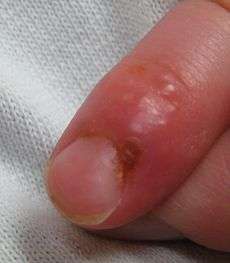Herpetic whitlow
| Herpetic whitlow | |
|---|---|
 Herpetic whitlow in a young child who earlier had developed herpes gingivostomatitis. | |
| Classification and external resources | |
| ICD-10 | B00.8 |
| ICD-9-CM | 054.6 |
A herpetic whitlow is a lesion (whitlow) on a finger or thumb caused by the herpes simplex virus. It is a painful infection that typically affects the fingers or thumbs. Occasionally infection occurs on the toes or on the nail cuticle. Herpes whitlow can be caused by infection by HSV-1 or HSV-2.[1] HSV-1 whitlow is often contracted by health care workers that come in contact with the virus; it is most commonly contracted by dental workers and medical workers exposed to oral secretions.[2][3] It is also often observed in thumb-sucking children with primary HSV-1 oral infection (autoinoculation) prior to seroconversion,[1] and in adults aged 20 to 30 following contact with HSV-2-infected genitals.[4] Symptoms of herpetic whitlow include swelling, reddening and tenderness of the skin of infected finger. This may be accompanied by fever and swollen lymph nodes. Small, clear vesicles initially form individually, then merge and become cloudy. Associated pain often seems large relative to the physical symptoms. The herpes whitlow lesion usually heals in two to three weeks.[5] It may reside in axillary sensory ganglia to cause recurrent herpetic lesions on that arm or digits.
Causes
In children the primary source of infection is the orofacial area, and it is commonly inferred that the virus (in this case commonly HSV-1) is transferred by the cutting, chewing or sucking of fingernail or thumbnail.
In adults it is more common for the primary source to be the genital region, with a corresponding preponderance of HSV-2. It is also seen in adult health care workers such as dentists because of increased exposure to the herpes virus.
Contact sports are also a common source of infection with herpetic whitlows.[6]
Treatment
Although it is a self-limited illness, oral or intravenous antiviral treatments, particularly acyclovir, have been used in the management of immunocompromised or severely infected patients. Topical acyclovir has not been shown to be effective in management of herpetic whitlow. Lancing or surgically debriding the lesion may make it worse by causing a superinfection or encephalitis.[7]
See also
References
- 1 2 Clark DC (2003). "Common acute hand infections". Am Fam Physician 68 (11): 2167–76. PMID 14677662.
- ↑ Lewis MA (2004). "Herpes simplex virus: an occupational hazard in dentistry". Int Dent J 54 (2): 103–11. doi:10.2956/indj.2004.54.2.103. PMID 15119801.
- ↑ Avitzur Y, Amir J (2002). "Herpetic whitlow infection in a general pediatrician--an occupational hazard". Infection 30 (4): 234–6. doi:10.1007/s15010-002-2155-5. PMID 12236568.
- ↑ Wu IB, Schwartz RA (2007). "Herpetic whitlow". Cutis 79 (3): 193–6. PMID 17674583.
- ↑ Anonymous (1971). "Herpetic whitlow: a medical risk". Br Med J 4 (5785): 444. doi:10.1136/bmj.4.5785.444. PMC 1799611. PMID 5125276.
- ↑ http://www.ncbi.nlm.nih.gov/pmc/articles/PMC3503926/#b2-184e924
- ↑ http://www.uptodate.com/contents/overview-of-hand-infections?source=preview&anchor=H27991206&selectedTitle=2~12#H27991206
External links
- Herpetic Whitlow Medscape
- Herpetic whitlow an occupational hazard, AANA J. 1990 Feb;58(1):8–13. Klotz R.W. PMID 2316323
| ||||||||||||||||||||||||||||||||||||||||||||||||||||||||||||||||||||||||||||||||